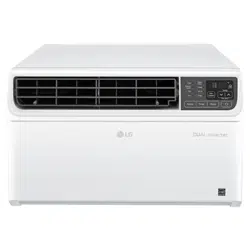Documents: Go to download!
- User Manual - (English, Spanish)
Owner's Manual Air Conditioner
PRODUCT OVERVIEW
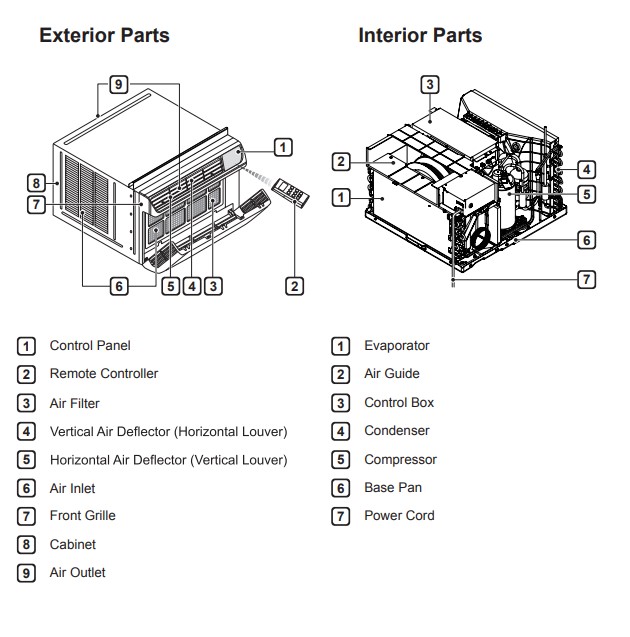
INSTALLATION
Electrical Data
- Power cord may include a current interrupter device. TEST and RESET buttons are provided on the plug case. The device should be tested on a periordic basis by first pressing the TEST button and then the RESET button. If the TEST button does not trip or if the RESET button will not stay engaged, discontinue use of the air conditioner and contact a qualified service technician
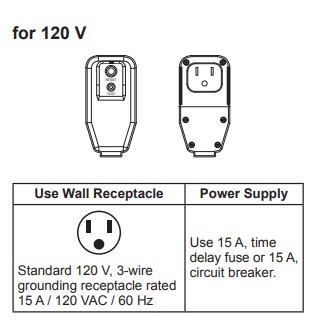
WARNING
- This appliance should be installed in accordance with the National Electrical Code.
- Use of extension cords could cause serious injury or death.
- Do not use an extension cord with this window air conditioner.
- Do not use surge protectors or multi-outlet adapters with this window air conditioner.
- Never push the TEST button during operation. Doing so can damage the plug.
- Do not remove, modify, or immerse this plug. If this device trips, the cause should be corrected before further use.
CAUTION: The conductors inside this cord are surrounded by shields, which monitor leakage current. These shields are not grounded. Periodically examine the cord for any damage. Do not use this product in the event the shields become exposed. Avoid shock hazard. This unit cannot be user-serviced. Do not open the tamperresistant sealed portion. All warranties and performance will be voided. This unit is not intended to be used as an ON/OFF switch
Installation Overview
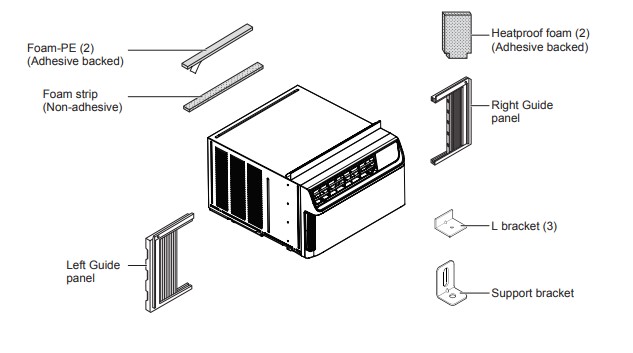
Accessories
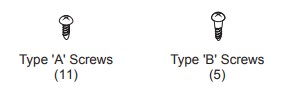
Tools Needed
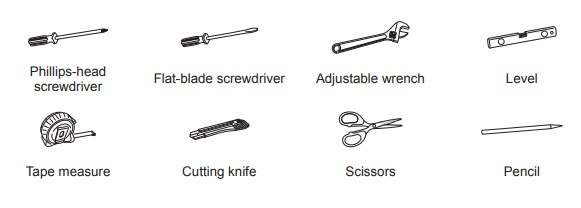
How to Install the Unit
1. To prevent vibration and noise, make sure the unit is installed securely and firmly.
2. Install the unit where the sunlight dose not shine directly on the unit.
3. The outside of the cabinet must extend outward for at least 12" and there should be no obstacles, such as a fence or wall, within 20" from the back of the cabinet because it will prevent heat radiation of the condenser. Restriction of outside air will greatly reduce the cooling efficiency of the air conditioner.

4. Install the unit slightly tilted so the back is slightly lower than the front (about 1/4"). This will force condensed water to flow to the outside.
5. Install the unit with the bottom between 30" ~60" above the floor level.
Window Requirements
- This unit is designed for installation in standard double hung windows with actual opening widths from 22" to 36". The top and bottom window sashes must open sufficiently to allow a clear vertical opening of 13" from the bottom of the upper sash to the inside sill.

- NOTE: This prodcut is a WINDOW AIR CONDITIONER. As such, a standard single-hung or double-hung window is required for proper installation. No-window installations, including using sleeves, holes in walls, and other installations are not recommended.
Clearance
Proper clearance enhances the cooling efficiency of the product.
- If a storm window presents interference, fasten a 2” wide wood strip to the inner window sill across the full width of the sill. The wood strip should be thick enough to raise the height of the window sill so that the unit can be installed without interference by the storm window frame.
- (See drawing.) The top of the wood strip on the inside sill should be approximately ¾” higher than the storm window frame or wood strip on the outside sill to help condensation to drain properly to the outside.
- If necessary, install a second wood strip (same thickness as first strip) in the center of sill flush against the back off the inner sill. This will raise the L bracket as shown in the drawing.

Preparation of Unit
1. Insert the top and bottom rails of the curtain panels into the upper and lower panel guides.

2. Fasten the curtain

3. Cut the window sash seals to the proper length. Peel off the backing and attach the Foam-PE(Adhesive backed) to the underside of the window sash and bottom of window frame.

4 Open the window and mark center line on the center of the inner sill.
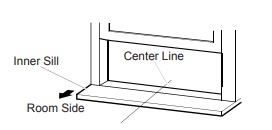
5. Install the L bracket behind the inner window sill, with short side of bracket as shown. Use the 2 Type A screws provided

Unit Installation
1. Set the air conditioner in the window so that is centered. Place the air conditioner so that front edge of the bottom guide is against the back edge of the sill. Bring the window down so that the front edge of the upper guide is in front of the window. Make sure that air conditioner is level or tilting slightly to the outside.
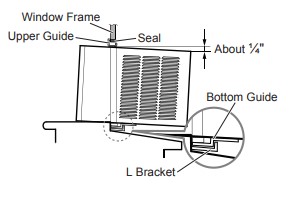
2. Extend the guide panels to fill the window opening using 4 Type B screws to secure them.

3. Cut the non-adhesive foam strip to the proper length and insert it between the upper window sash and the lower window sash.
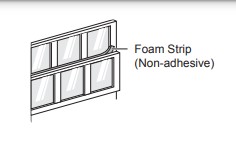
4. Attach the window locking bracket with a type A screw.
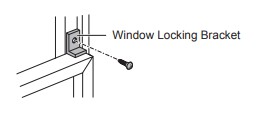
NOTE: Fasten the remaining L bracket to the outer window sash with 1 type A screw as shown
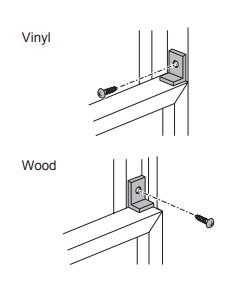
5. Remove the screw form the right side of cabinet. Fasten the support bracket using a removed from the air conditioner cabinet. Attach the support bracket to the inner window sill with a Type B screw.
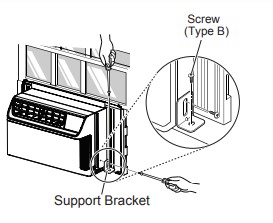
6. Cut the adhesive-backed heatproof foam to match the size of the curtain panels. Remove the backing from the heatproof foam and attach it to the curtain panels. Heatproof foam improves the cooling capability of the air conditioner.

NOTE: See the 'Electrical Data' section for information on attaching the power cord to an electrical outlet.
OPERATION
Control Panel and Remote Control

1. Power
- Press to turn the air conditioner ON or OFF
2. Sleep Mode
- This mode keeps operating noise to a minimum and turns the air conditioner off after a set time. The timer can be set from 1 to 7 hours.
- In the Sleep Mode, the setting temperature increases by 2 °F after 30 minutes and additional 2 °F after another 30 minutes for a more comfortable sleep.
- The setting temperature increases up to 4 °F from the preset temperature.
3. Delay ON/OFF Timer
- Delay ON - When the air conditioner is off, set it to automatically turn on from 1 to 24 hours later, at its previous mode and fan settings.
- Delay OFF - When the air conditioner is on, set it to automatically turn off from 1 to 24 hours later
- NOTE: Each press of the Timer button advances the timer by 1 hour. After the last press the display returns to the temperature setting.
4. Operation Mode
- Press the Mode button to cycle between 4 types of air conditioner operation: Energy Saver / Cool / Fan Only / Dry.
Energy Saver - In this mode the compressor and fan turn off when the set temperature is achieved. Approximately every 3 minutes the fan turns on to allow the unit sensor to accurately determine if more cooling is needed
Cool - This mode is ideal on hot days to cool and dehumidify the room quickly. Use the Temp  buttons to set the desired room temperature and use the Fan Speed button to set the desired fan circulation speed
buttons to set the desired room temperature and use the Fan Speed button to set the desired fan circulation speed
Fan Only - In this mode the fan circulates air but the compressor does not run. Use the Fan Speed button to set fan speed to High, Medium or Low. In this mode, you cannot adjust the set temperature.
Dry - This mode is ideal for rainy and damp days to dehumidify the room rather than cooking is significantly. Humidity is removed from the room by the combination of compressor operation and the fan speed fixed at Low. The compressor and fan turn off once the set temperature is reached. Fan speed cannot be adjusted in Dry mode
5. Wi-Fi
- Enables connection of the air conditioner to the home Wi-Fi.
6. Clean Filter
- The Clean Filter LED lights up to notify you that the filter needs to be cleaned. After cleaning the filter, press Temp
 and
and  together on the control panel to turn off the Clean Filter light.
together on the control panel to turn off the Clean Filter light.
7. Fan Speed: Press to set the fan speed to Low (F1), Medium (F2), or High (F3).
8 Temperature Control: The thermostat monitors room temperature to maintain the desired temperature. The thermostat can be set between 60 °F–86 °F (16 °C–30 °C). Press  or
or  arrows to increase or decrease temperature setting.
arrows to increase or decrease temperature setting.
9. Energy Saver:In this mode the compressor and fan turn off when the set temperature is achieved. Approximately every 3 minutes the fan turns on to allow the unit sensor to accurately determine if more cooling is needed.
10. Clear: Cancel Sleep and Timer settings.
Air Direction
Airflow can be adjust by changing the direction of the air conditioner’s louvers.
Adjusting horizontal Airflow Direction
- The horizotal airflow is adjusted by moving the levers of the vertical louvers to the left or right
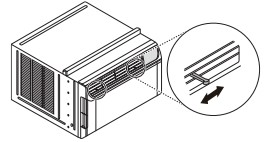
Adjusting horizontal Vertical Direction
- Touch the horizotal louvers to adjust the airflow up or down.

NOTE: When the weather is extremely hot, the unit may turn off automatically to protect the compressor.
Additional Features
Slinger Fan
- This air conditioner is equipped with a slinger fan. (See drawing.)
- The fan’s outer ring picks up the condensed water from the base pan if the water level gets high enough. The water is then picked up by the fan and expelled through the condenser, making the air conditioner more effiicient
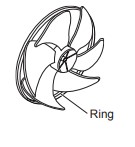
SMART FUNCTIONS
Using LG ThinQ Application
Things to check before using LG ThinQ
For appliances with the  or ThinQ logo
or ThinQ logo
1. Check the distance between the appliance and the wireless router (Wi-Fi network).
- If the distance between the appliance and the wireless router is too far, the signal strength becomes weak. It may take a long time to register or installation may fail.
2. Turn off the Mobile data or Cellular Data on your smartphone.
- For iPhones, turn data off by going to Settings → Cellular → Cellular Data.

3. Connect your smartphone to the wireless router.
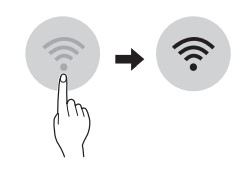
NOTE
- To verify the Wi-Fi connection, check that Wi-Fi
 icon on the control panel is lit.
icon on the control panel is lit. - The appliance supports 2.4 GHz Wi-Fi networks only. To check your network frequency, contact your Internet service provider or refer to your wireless router manual.
- LG ThinQ is not responsible for any network connection problems or any faults, malfunctions, or errors caused by network connection.
- If the appliance is having trouble connecting to the Wi-Fi network, it may be too far from the router. Purchase a Wi-Fi repeater (range extender) to improve the Wi-Fi signal strength.
- The Wi-Fi connection may not connect or may be interrupted because of the home network environment.
- The network connection may not work properly depending on the Internet service provider.
- The surrounding wireless environment can make the wireless network service run slowly.
- The appliance cannot be registered due to problems with the wireless signal transmission. Unplug the appliance and wait about a minute before trying again.
- If the firewall on your wireless router is enabled, disable the firewall or add an exception to it.
- The wireless network name (SSID) should be a combination of English letters and numbers. (Do not use special characters.)
- Smartphone user interface (UI) may vary depending on the mobile operating system (OS) and the manufacturer.
- If the security protocol of the router is set to WEP, you may fail to set up the network. Please change it to other security protocols (WPA2 is recommended) and register the product again.
Installing LG ThinQ
- Search for the LG ThinQ application from the Google Play Store or Apple App Store on a smart phone. Follow instructions to download and install the application.
Wi-Fi Function
- For appliances with the
 or ThinQ logo Communicate with the appliance from a smart phone using the convenient smart features.
or ThinQ logo Communicate with the appliance from a smart phone using the convenient smart features. - Settings: Allows you to set various options on the appliance and in the application.
NOTE
- If you change your wireless router, Internet service provider or password, delete the registered appliance from the LG ThinQ application and register it again.
- The application is subject to change for appliance improvement purposes without notice to users
- Functions may vary by model.
MAINTENANCE
WARNING: Before cleaning or performing maintenance, disconnect the power supply and wait until the fan stops.
Air Filter
Check air filter at least twice a month to see if cleaning is necessary. Trapped particles in the filter can build up and block the airflow, reducing cooling capacity and causing an accumulation of frost on the evaporator.
Cleaning the Air Filter
1. Remove the air filter from the front grille by pulling the filter forward and then up slightly
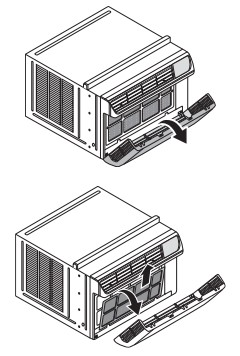
2. Wash the filter using lukewarm water below 40 °C (104 °F)
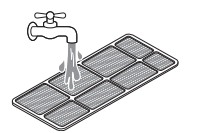
3 Gently shake the excess water from the filter and replace
4. Dry the filter in the shade.
5. Insert the filter into the front grille.
Cleaning the Air Conditioner
- Wipe the front grille and inlet grille with a cloth dampened in a mild detergent solution.
- Wash the cabinet with mild soap or detergent and lukewarm water, then polish using liquid appliance wax.
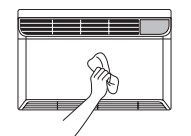
NOTE
- To ensure continued peak efficiency, the condenser coils (outside of unit) should be checked periodically and cleaned if clogged with soot or dirt from outside air.
- For repair and maintenance, contact an Authorized Service Center. See the warranty page for details or call 1-800-243-0000. Have your model number and serial number available. They should be written on page 27 of this manual.
TROUBLESHOOTING
Before Calling for Service
- The appliance is equipped with an automatic error-monitoring system to detect and diagnose problems at an early stage. If the appliance does not function properly or does not function at all, check the following before you call for service.
Normal Sounds You May Hear
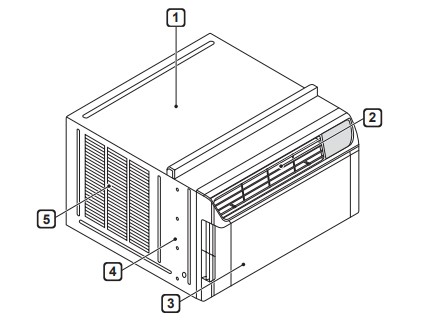
1 High Pitched Chatter: Today's high efficiency compressor may have a high pitched chatter during the cooling cycle.
2 Sound of Rushing Air: At the front of the unit, you may hear the sound of rushing air being moved by the fan.
3 Gurgle/Hiss: Gurgling or hissing noise may be heard due to refrigerant passing through evaporator during normal operation.
4 Vibration: Unit may vibrate and make noise because of poor wall or window construction or incorrect installation.
5 Pinging or Swishing: Droplets of water hitting condenser during normal operation may cause pinging or swishing sounds.
1. Air conditioner does not start.
- The air conditioner is unplugged.
- Make sure the air conditioner plug is pushed completely into the outlet.
- The fuse is blown/circuit breaker is tripped.
- Check the house fuse/circuit breaker box and replace the fuse or reset the breaker.
- Power failure.
- If power failure occurs, turn the mode control to off. When power is restored, wait 3 minutes to restart the air conditioner to prevent tripping of the compressor overload.
- The current interrupter device is tripped.
- Press the RESET button located on the power cord plug. If the RESET button will not stay engaged, discontinue use of the air conditioner and contact a qualified service technician.
2. Air conditioner does not cool as it should
- Airflow is restricted
- Make sure there are no curtains, blinds, or furniture blocking the front of the air conditioner.
- The temp control may not be set correctly.
- Set the desired temperature to a level lower than the current temperature.
- The air filter is dirty
- Clean the filter at least every 2 weeks. See the 'MAINTENANCE' section.
- The room may have been hot.
- When the air condiyioner is first turned on, you need to allow time for the room to cool down.
- Cold air is escaping.
- Check for open furnace floor registers and cold air returns.
- Cooling coils have iced up.
- See 'Air conditioner freezing up' below.
3. Air conditioner freezing up.
- The cooling coils are iced over.
- Ice may block the air flow and obstruct the air conditioner from properly cooling the room. Set the mode control at High Fan or High Cool.
4. Water drips outside.
- Hot, humid weather.
- This is normal.
5. Water drips indoors.
- The air conditioner is not tilted to the outside.
- For proper water disposal, make sure the air conditioner slants slightly from the cabinet front to the rear.
6. Water collects in base pan.
- Moisture removed from air and drains into base pan.
- This is normal for a short period in areas with little humidity; normal for a longer period in very humid areas.
7. Air conditioner turns on and off rapidly
- Dirty air filter - air restricted
- Clean air filter
- Outside temperature extremely hot.
- Refer to installation instructions or check with installer.
8 Noise when unit is cooling.
- Air movement sound.
- This is normal. If too loud, set to lower FAN setting.
- Window vibration - poor installation.
- Refer to installation instructions or check with installer.
9 Room too cold.
- Set temperature too low.
- Increase set temperature.
10. Can't connect the LG ThinQ App. to the air conditioner
- Air conditioner is turned off.
- Turn the air conditioner on.
- Wireless router is turned off.
- Turn the router on.
11. The air conditioner is not connecting to the Wi-Fi.
- The Wi-Fi router is too far from the air conditioner.
- Move the router closer to the air conditioner or purchase and install a Wi-Fi repeater (signal booster).
- You do not have permission to use the router or it is incompatible.
- Make sure you are selecting the correct wireless router from the list. The router must be set to 2.4 GHz
NOTE
- You can refer to the Energy Star program in detail at energystar.gov.
- If you see "CH" in the display, please call 1-800-243-0000.
Wi-Fi
1. Trouble connecting appliance and smartphone to Wi-Fi network.
- The password for the Wi-Fi network was entered incorrectly.
- Delete your home Wi-Fi network and begin the registration process again.
- Mobile data for your smartphone is turned on.
- Turn off the Mobile data on your smartphone before registering the appliance.
- The wireless network name (SSID) is set incorrectly
- The wireless network name (SSID) should be a combination of English letters and numbers. (Do not use special characters.)
- The router frequency is not 2.4 GHz.
- Only a 2.4 GHz router frequency is supported. Set the wireless router to 2.4 GHz and connect the appliance to the wireless router. To check the router frequency, check with your Internet service provider or the router manufacturer.
- The distance between the appliance and the router is too far.
- If the appliance is too far from the router, the signal may be weak and the connection may not be configured correctly. Move the router closer to the appliance or purchase and install a Wi-Fi repeater
See other models: 22LV2500 LSXS26336D 43UU670H OLED88Z9PUA DLGX7801WE
